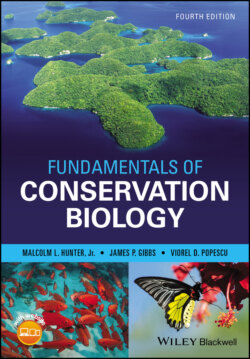Читать книгу Fundamentals of Conservation Biology - Malcolm L. Hunter Jr. - Страница 110
Cultural Diversity
ОглавлениеThe sharing of genes between parents and offspring is not the only mechanism by which information is transmitted from one generation to the next. Among many social animals information also moves among individuals and generations through learning, a process often called cultural transmission. Because changes in behavior can occur much faster than evolution, cultural diversity can be critical for adaptation to new circumstances, including global change, particularly for long‐lived animals.
Methods for exploiting novel food items provide some of the best‐documented examples of cultural transmission; one such example occurred when the knowledge that food could be obtained by pecking open the caps of milk bottles spread among the blue tits of England (Fisher and Hinde 1949). The location of migration routes, water holes, food patches, nesting sites, and hibernacula may be learned by young animals following old animals. For example, it is likely that the matriarchs of elephant herds know the location of water in times of drought and can lead their herds there (Moss 1988). If a herd’s matriarch were killed by poachers before the information could be transmitted, the cultural diversity of that elephant herd would be diminished, perhaps with disastrous consequences. Highly endangered whooping cranes provide yet another example: older, more experienced birds with their greater knowledge of the landscape guide flocks to overwintering sites that are more beneficial (warmer and more food available) than typically used sites that younger birds would tend to return to without guidance of the older birds (Teitelbaum et al. 2016).
Conversely, breakdown of cultural transmission has been a problem for conservationists. For example, golden lion tamarins released into their native habitat have had problems identifying food and predators, information that they would have learned from other tamarins under normal circumstances (Kleiman 1989). Many marine mammals have specific dialects unique to particular locales or even social groups, as in the case of sperm whales (Gero et al. 2016). When populations are broken up and fragmented through over‐exploitation these long‐evolved communication systems also erode. Grazing animals like bighorn sheep and moose can take several generations to build their knowledge of their environment (where to go to find green forage), which poses a significant challenge to reintroducing species to ranges unfamiliar to them (Jesmer et al. 2018).
Among all species, Homo sapiens has the most complex culture, and maintaining human cultural diversity should also be of some concern to conservation biologists. For example, regions of the globe with the highest levels of biological diversity also host the greatest human language diversity (Sutherland 2003). Notably, the very factors that beget biological diversity, such as isolating mechanisms like mountain ranges, rivers, and islands, also beget cultural and language diversity in humans. Yet the same forces of homogenization that are threatening biological diversity are also threatening human cultural diversity: of the estimated 6000 languages spoken in 2000 some 50–90% may not survive through the twenty‐first century (Crystal 2000).
Of course, it is hard to imagine conservation biology encompassing humanity’s physical diversity, languages, art, music, science, literature, architecture, and so on. When conservation biologists think about maintaining human cultural diversity, they usually focus on the diverse ways in which rural people, especially people who still use traditional technology, interact with the ecosystems in which they live. For example, ethnobotanists are particularly concerned about maintaining the cultures associated with human use of plants for food, medicine, and other purposes (Balick and Cox 1996 ; Nazarea 1998 ; Gao 2003). Moreover, indigenous peoples have intimate knowledge of wild species and their interactions that can greatly improve endangered species efforts (Nabhan 2000 ; Salomon et al. 2015). Because humans have placed cultural importance on biodiversity for thousands of years and we know that biodiversity can directly affect human health, we expect that biodiversity loss will negatively impact human health via well‐established cultural pathways (Clark et al. 2014). A specific example is the African honey guide (Fig. 5.13), which reveals ancient connections between human welfare and wild species via shared cultural linkages. More generally, human diets have become simplified with increased accessibility of inexpensive agricultural commodities, and erosion of biodiversity in agriculture and food has led to consequences for human health and well‐being. Once lost, traditional systems that link wild species as food sources to human health are hard to recreate (Johns and Eyzaguirre 2006).
Figure 5.13 Wild animals and humans have long shared culture based on collaborating to find food. A famous example is in Africa, where greater honey guides (a) lead human honey hunters to bee colonies, and the humans, on opening up the nest, leave some food for the birds to feast on (Spottiswoode et al. 2016; B.M. Wood et al. 2014). (b) Similarly, in western Mongolia, Kazakh peoples use golden eagles, northern goshawks, peregrine falcons, saker falcons, and other raptors to hunt foxes and hares during the cold winter months with the hunters securing the pelts and the raptors some or all of the meat.
([a] Dominic Sherony/Wikimedia Commons/CC BY‐SA 2.0 [b] Mark Robinson/Alamy Stock Photo)
In short, conserving human cultural diversity along with biological diversity and interactions between the two is fertile ground for collaboration among conservation biologists, anthropologists, and others. Perhaps the explosion of techniques, approaches, and applications of genetics to conservation (Box 5.1) will expand into the future to address issues conserving cultural diversity as well.
